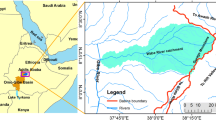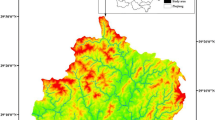Abstract
Several environmental protection policies have been implemented to prevent soil erosion and nonpoint source (NPS) pollutions in China. After severe Yangtze River floods, the “conversion cropland to forest policy” (CCFP) was carried out throughout China, especially in the middle and upper reaches of Yangtze River. The research area of the current study is located in Bazhong City, Sichuan Province in Yangtze River watershed, where soil erosion and NPS pollution are serious concerns. Major NPS pollutants include nitrogen (N) and phosphorus (P). The objective of this study is to evaluate the long-term impact of implementation of the CCFP on stream flow, sediment yields, and the main NPS pollutant loading at watershed level. The Soil and Water Assessment Tool (SWAT) is a watershed environmental model and is applied here to simulate and quantify the impacts. Four scenarios are constructed representing different patterns of conversion from cropland to forest under various conditions set by the CCFP. Scenario A represented the baseline, i.e., the cropland and forest area conditions before the implementation of CCFP. Scenario B represents the condition under which all hillside cropland with slope larger than 25° was converted into forest. In scenario C and D, hillside cropland with slope larger than 15° and 7.5° was substituted by forest, respectively. Under the various scenarios, the NPS pollution reduction due to CCFP implementation from 1996–2005 is estimated by SWAT. The results are presented as percentage change of water flow, sediment, organic N, and organic P at watershed level. Furthermore, a regression analysis is conducted between forest area ratio and ten years’ average NPS load estimations, which confirmed the benefits of implementing CCFP in reducing nonpoint source pollution by increasing forest area in mountainous areas. The reduction of organic N and organic P is significant (decrease 42.1% and 62.7%, respectively) at watershed level. In addition, this study also proves that SWAT modeling approach can be used to estimate NPS pollutants’ impacts of land use conversions in large watershed.









Similar content being viewed by others
References
Arnold JG, Allen PM, Muttiah RS, Bernhardt G (1995) Automated base flow separation and recession analysis techniques. Ground Water 33(6):1010–1018
Arnold JG, Fohrer N (2005) SWAT2000: current capabilities and research opportunities in applied watershed modeling. Hydrologic Processes 19:563–572
Arnold JG, Srinivasan R, Muttiah RS (1998) Large area hydrologic modeling and assessment. Part I: Model development. Journal of the American Water Resources Association 34(1):73–89
Attwood JD, McCarl B, Chi-Chung Chen, et al. (2000) Assessing regional impacts of change: linking economic and environmental models. Agricultural Systems. 63(3):147–159
Behera S, Panda R (2006) Evaluation of management alternatives for an agricultural watershed in a sub-humid subtropical region using a physical process based model. Agriculture, Ecosystems and Environment 113:62–72
Chen ChingHo, Liu WeiLin, Leu HorngGuang (2006) Sustainable Water Quality Management Framework and a Potential impacts of climate change on groundwater recharge and stream flow in a central European low mountain range. Journal of Hydrology 284:244–252
Cheng Hongguang, Ouyang Wei, Hao Fanghua, et al. (2007) The Non-point Source Pollution in Livestock-breeding Areas of the Heihe Riverbasin in Yellow River. Journal of Stochastic Environmental Research & Risk Assessment 21(3):213–221
Eckhardta K, Ulbrich U (2003) Strategy Planning System for a River Basin. Environmental Management 38:952–973
Martin Plusa, Isabelle La Jeunesseb, Faycal Bouraoui, et al. (2006) Modelling water discharges and N inputs into a Mediterranean lagoon impact on the primary production. Ecological Modelling 193:69–89
Ramanarayanan TS, Srinivasan R, Arnold JG (1996) Modeling Wister Lake Watershed using a GIS-linked basin scale hydrologic water quality model. In: Third International Conference on Integrating Geographic Information Systems and Environmental Modeling, January, Santa Fe, NM
Santhi C, Srinivasan R, Arnold JG (2006) A modeling approach to evaluate the impacts of water quality management plans implemented in a watershed in Texas. Environmental Modelling & Software 21:1141–1157
Tripathi MP, Panda RK, Raghuwanshi NS (2003) Identification and Prioritization of Critical Sub-watersheds for Soil Conservation Management using the SWAT Model. Biosystems Engineering 85(3):365–379
Wang Qingeng, Gu Gang, Yoshiro Higano (2006) Toward Integrated Environmental Management for Challenges in Water Environmental Protection of Lake Taihu Basin in China. Environmental Management 37(5):579–588
Wanga, Ouyanga H, Maclarenc V (2006) Evaluation of the economic and environmental impact of converting cropland to forest: A case study in Dunhua county, China. Journal of Environmental Management. Article in Press. Available online 22 December
Yin Hongfu, Li Changan (2001) Human impact on floods and flood disasters on the Yangtzeriver. Geomorphology 41(2–3):105–109
Zhang H (2003) Guidance and Practice of Converting Cropland to Forest, Chinese Press of Agricultural Science and Technology 2003:3–120
Zhang J, Jogensen SE (2005) Modelling of point and non-point nutrient loadings from a watershed. Environmental Modelling and Software 20:561–574
Zhang Xinbao, Zhang Yiyun, Wen Anbang, et al. (2003) Assessment of soil losses on cultivated land by using the 137Cs technique in the Upper Yangtze River Basin of China. Soil and Tillage Research. 69(1-2):99–106
Acknowledgments
The authors gratefully acknowledges the Chinese National Nature Science Committee for financial support, which enabled this research (Grant Number 40471127). We would also like to thank the local helpers who assisted during the field investigations and the local governments for providing data.
Author information
Authors and Affiliations
Corresponding author
Rights and permissions
About this article
Cite this article
Ouyang, W., Hao, FH., Wang, Xl. et al. Nonpoint Source Pollution Responses Simulation for Conversion Cropland to Forest in Mountains by SWAT in China. Environmental Management 41, 79–89 (2008). https://doi.org/10.1007/s00267-007-9028-8
Published:
Issue Date:
DOI: https://doi.org/10.1007/s00267-007-9028-8




